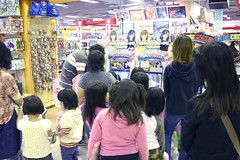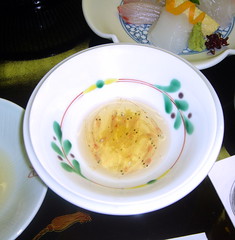Monday, May 22, 2006
Oshare Majou (The Best Dressed Witch)
The Sega video game, "Oshare Majou Mahou Card" (Magic Card of the Best Dressed Witch), allows Japanese girls to turn themselves into well dressed dancing caucasians in the virtual.
Oshare means "dressed up" or "well dressed" but as well see, this is a competitive game so I have rendered it as "Best Dressed"
The official site is in Japanese.
The game seems to be a combination of a virtual version of the video dance game "Dance Dance Revolution," and virtual fashion using swipe cards, in a competitive format. Players purchase clothes which their virtual personas wear before taking on the computer or a friend in a battle of who is the most "oshare," where oshare means well dressed and cooly attractive at dancing. By pressing the keys in time with the music, the young lady with the best fashion sense (I am not sure of the criteria) and best moves, wins the battle of the Best Dressed Witch. Perhaps this information is stored on the swipe card. I am not sure.
The two girls are called "Rabu and Beri-" ("Love and Berry") often being appended to "RabuBeri" or "Raberi" ("lovely"). In their cartoon form these characters are pretty Mid Pacific as are many manga characters, with features that do not define them as being part of any race or nation.
Recently two caucasian models have been used to represent Love and Berry in some magazine adverts directed at young girls.
The game is enjoying immense popularity with cues of preteen girls and their parents forming at video arcades all over Japan.
Labels: japan, japanese culture, nihonbunka, westernisation, 日本文化
Sunday, May 14, 2006
Yaoi - No Mountains, No Valleys, No Meaning, Just Gay Sex
Yaoi comics are purchased by young women who find reading books about male-male romantic/sexual relationships, to be less embarassing and more interesting than reading about relationships between men and women. Most commentators suggest that this is because women are repressed and want to identify with males who have a slightly better, freeer, more expressive position in Japanese society. I think that this interpretation only slightly misses the mark.
As I have mentioned elsewhere, it seem that in Japan, expressions of *male* sexuality are not taboo, whereas any expression of female desire has been hidden since the beginning of time. Hence, when young girls want to read about romantic love and sexuality, they find man on man love and lust, pure and innocent and unthreatening.
There is method to this madness. I call it Japan as Lacan in the mirror.
Labels: culture, japan, japanese culture, Jaques Lacan, lacan, manga, nihonbunka, sex, taboo, tabuu, theory, 日本文化
Buddhist Scriptures Unread
This is the first time that the base of the temple has been open to the viewing public. Normally the only person to enter the temple is the priest who goes to extract one part of one volume of the scripture. For the rest of the time, all the information, all the philosophy held in this tower is treated as a holy relic. No one reads it. No one looks at it. It is just there.
Not only is Japanese Buddhist scripture "unread" I would go far as to say say that *anti-logocentrism* is a prominent feature of *Japanese* Buddhism or perhaps the Shinto-Buddhist syncretism that exists in Japan.
Zen Buddhism is quite clear about this. Zen buddhism claims (in lanaguage) to be the Buddhism outside of scripture (language). Zen Buddhists are not afraid of the liars' paradox, but slap it in the face.
And most Japanese lay Buddhists use the scripture not as something that explains why the world is as it is -- a mental structure confabulated by the minds of humans -- because to become so involved with the scripture would be to make another structure, another confabulation. Instead they *chant* thewordsthatclaimitisallaconfabulationandbydoingso...reach the empty, wordless, truth.
My bashing people over the head with Buddhist books photo set is "arguing" (by bashing) the or their authors are Cretians, right and wrong at the same time. Thus, rather than get all fussed about paradoxes, Japanese Buddhist priests just bash people over the head with the books, and be done with it.
But this is not news to Gnostics. In the beginning was the word. Before that there was the demi-urge. Or was it the Buddha?
Labels: japan, japanese culture, nihonbunka, 日本文化
Hard Gay Toy
He appears to be popular among young children. This produced by TOMY is for preschool children.
The entertainer is, in real life, heterosexual. I think that it is important however that he is mimicing the sexual activities of male homosexual, since in Japan it seems, that while male sexuality are not taboo the sexuality of women is. Thus, in this and other situations, due to the absense of any female participation, portrayal of purely male sexuality, in the form of male homosexuality, is deemed fit for consumption even by children.
Since in the West, the severity of taboos upon male and female sexuality may be reversed, it is concievable that there is nothing more likely to cause offence than the portrayal of male homosexuality.
I do not think that the tolerance towards such portrayals has a lot to do with the tolerance towards real homosexuality in Japan today, at least according to small sample of gays that I have met. Today, I am told, it is not easy to be gay or come out in Japan.
****************************************************************************************
I meant to write about cultural differences, not about the reasons for negative reactions towards homosexuality in the West but I have. And since I have, I feel that I should say a bit more about what I am asserting; homosexuality in the West is doubly damned for being both homo and sexual:
1) "homo" as opposed to hetro and thus different, and just because it is different the object of prejudice
2) "sexual", in the sense of being related to sex act and thus associated with that which is often the object of taboo in the Western tradition.
But, I am sure that there are factors too, and all of them are unfortunate.
Labels: japan, japanese culture, nihonbunka, sex, 日本文化
Kitty Car
In Japan there is a tremendous tabu upon the sexuality of women. This can be seen in the fact that while men pee on the streets women use "sound princess" devices to hide even the sound of their pee. Or again in the fact that women who express their desire are seen as being monsters, such as Hanya.
As argued by Foucalt and others, any desire that is repressed returns in other forms. The more a desire is repressed, the more it comes back in a modified cleansed, neutered way.
While Japanese women are not allowed to give expression to their desire directly, Japanese society is awash with expressions of de-wombed maternal love. Being cute (kawaii) is very positive and important. Perceiving things as cute (kwaiiiiiii) is likewise postive and important. And surrounding oneself with cute things, such as many "hello kitty" cat dolls is likewise a ritual expression of womb based sexuality without the womb. In this car there are babies everywhere but they are all made of polyester and nylon. There were even baby sized dolls on the back seat.
The hello kitty characters on the back seat are the size of young children. The numberplate is held on by Hello Kitty headed screws and the water jets for the windscreen are squirted from a Hello Kitty capped nozzle.
Hello Kitty is copyright the Sanrio corporation.
Labels: japan, japanese culture, nihonbunka, 日本文化
De Rigueur Cute
Between its legs, by chance, is a pine cone containing stuffed, coloured cloth balls. The phone is connects to a local taxi company.
"Hello Kitty" the name and design is copyright/tm Sanrio corporation.
Labels: japan, japanese culture, nihonbunka, 日本文化
Culture or Cruelty
The practice of eating small "shirao" fish live is a traditional way to celebrate the arrival of spring in Japan.
Is it cruel? Is it any more or less cruel than a beefburger?
I think that there are a lot of issues here.
1) The intelligence and ability to appreciate pain or suffering of the species that one is eating. I am not sure, but I think that there is a continuum between plants and animals. Are vegetables, viri, (yoghurt) baterial, algae, plankton, shripm, fish, sheep, cows, horses, pigs, dogs, whales, apes, okay to eat? I have probably got the order wrong and I think that some of these are of a similar level of intelligence, ability to appreciate pain or suffering. Here we are talking about a small fish. I am not sure of their level of awareness.
2) The suffering of the food. This is factored by the speed with which one kills the food, and the stress that the food suffers prior to its demise. There are laws about this in various countries that obviously relate to the criteria (1) above. Here we are talking about a fairly painful, slow, stressful method of killing.
3) Secondary impact of eating the food. Shiroibasket shoes mentions that he does not drink milk. Milk in itself probably does not suffer but the secondary impact of drinking milk is that cows or their offspring are slaughtered.
4) The reasons for eating the food. This is complex. I would like to point out two factors.
4.1) The nutritional importance to the eater. If the eater is going to starve then we are more likely, I think, to allow eating further up the food chain, even to the point where one might accept canibalism when there are three men in a boat and no food? Perhaps.
4.2) The symbolic factor. By this I mean to extent to which the food is eaten for...hmm...the significance that the food and its preparation has. There are all sorts of things going on here and I am not sure whether they are mitigating or incriminating. For example,
4.2.1) Eating steak because it is deemed manly, preditorial, strong to do so.
4.2.2) Eating dog because (perhaps) in part it is defying a tabuu, daredevil, radical, virile.
4.2.3) Eating cow that has been bleed to death due to beliefs about the purity of the food.
4.2.4) Eating these small fish for the awareness of the season and that one is an ominvore, or to return to ones nature.
4.2.4) Eating fish eggs (caviar) because they are expensive and by so doing we express our wealth.
4.2.5) Eating an animal as part of a ritual.
4.2.6) Eating a piece of bread that is believed to be a part of a human being, as in the Catholic Mass.
I do not know about how significance effects our appraisals of consumption but it is bound to depend upon whether that significance is shared. Significance is notoriously culturally determined, but perhaps there are ways appreciating the significance factor of others, by analogy from an awareness of the significance of ones own. In other words, someone that eats steak might think that eating fish live is brutal, until they become aware of the fact that their own steak eating is, like the fish eating, a symbolic act.
5) Cruelty for the sake of awareness of cruelty. (for a lack of a better way of putting it)
This is really a part of (4 - the significance) above but it interests me and I think that it bears upon the eating of these fish. First of all, I do not mean to assert the existance of universal "cruelty." Perceptions of cruetly are varied. However, I merely that there is a question in everyone's mind, "Is it okay to eat this?" Now, let us say that there are times when the answer is a mitigated "no." But one might still go ahead and do it in order to be aware of wider situation.
I think that perhaps, eating these fish live draws ones awareness to the fact that the bacon, steak, fish that one is eating are living. It draws ones attention to the horror of what one is doing. And by drawing attention to that horror, it causes the eater to be more wary and appreciative of the "cruelty" of their behaviour.
One might for example demand that all those that eat steak kill a cow with a sword every x years. Killing a cow with a sword, by ones own hand would be painful for the cow and the eater. But, it may result in a more balanced view of eating cow.
Personallly, I would like to insist that all those that eat steak and fish and any living thing, do it in the flesh every now and again.
In the extreme, it might be profitable to have people bite the cows neck, or if not bite it, then slit the throat of the cow with their own hand, or if not do that then at least whatch the cow being slaughtered. The act would brings home the reality of that which is otherwise taken for granted. Even it is an act that we might not approve of - slitting a cows throat is probably more painful for the cow than the present method of killing - but I think that if beefburger eaters were required to do this "cruetly" then they might more wary and aware of the consequences of ordering a Big Mac. And in that situation, perhaps, humans would eat animals at a more "acceptable" (this is my personal preference) rate.
So, I think that by drinking live fish the Japanese maintain an awareness of results their culinary preferences. When the Japanese stop eating live fish they may eat beefburgers as much as Britons and Americans. When this comes to pass, and we are on the way there, I think that it will be sad. So here is to cruelty for the sake of an awareness of cruelty.
Perhaps.
Labels: japan, japanese culture, nihonbunka, 日本文化
Bonjour they say
With images like this, it is not surprising that Japanese want to undergo cosmetic surgery to make their noses more pointy. At the same time, there may be more to this practice than meets the eye. I think that if the mannequins were Japanese then they would look too lifelike, too scary, since the Japanese identify more with the body.
Labels: japan, japanese culture, nihonbunka, 日本文化
Japanese Fashion Feminisation
In the West there seems to be a gradual masculinisation of fashion. Both boys and girls wear jeans (formerly male labourer's garb) and T-shirts (formerly boys sports wear). In Japan however, fashion is feminised. The guys have taken to wearing make up, and the girls tend towards the ultra-cute.
Labels: japan, japanese culture, nihonbunka, 日本文化
This blog represents the opinions of the author, Timothy Takemoto, and not the opinions of his employer.










